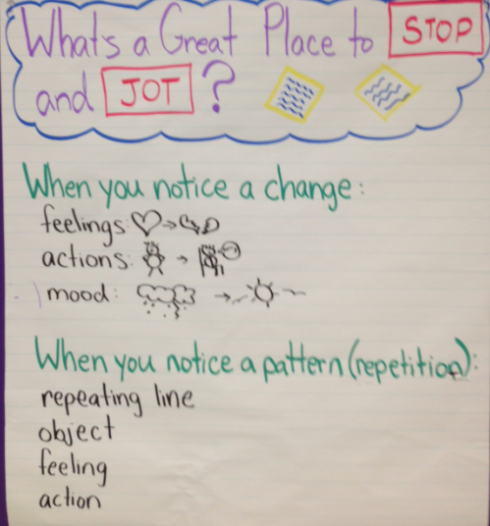We just concluded our book club unit, and as the kids closed Love That Dog with a sigh of satisfaction, I gave a mental cheer as well. I’m not generally much of a Pollyanna in class, but there were so many moments where they would gasp as I read aloud, and then furiously jot down a note to share with their group, or where I would ask them to discuss a small section and they would quickly erupt into a larger discussion that connected different pieces of the text together and looked for larger meaning. Pretty neat, huh?
I had to wonder, why were the kids so actively engaged in making meaning this time, when at other times (other read-alouds, other classes) it’s felt like more of a struggle?
This year, more than any other, we’ve been working on a few consistent signs that tell a reader something important is happening. And not just plot-important, but craft-important, character-development-important. We’ve been working on the idea that when something is repeated, or something changes, it’s a signal that the reader should get up and take notice. I’ll re-post the chart from an earlier post on the subject:
Love That Dog has a significant amount of repetition–it repeats objects, lines, and feelings. But it also has some clear changes. Jack, the main character, shifts from disliking poetry and feeling shy and scared, to being an avid poetry fan and confident poet. Every day reading the book was an opportunity for students to make another discovery, and they loved that.
Kylene Beers and Robert Probst recently came out with another book that identifies signals as well, only they have six. They call them “signposts”.
 Their signposts, in a nutshell, are:
Their signposts, in a nutshell, are:
• Contrasts and Contradictions: a sharp contrast between what we would expect and what we observe the character doing; behavior that contradicts previous behavior or well-established patterns like our “things that change”
• Aha Moment: a character’s realization of some that shifts his action or understanding of himself, others, or the world around him
• Tough Questions: questions a character raises that reveal his or her inner struggles
• Words of the Wiser: the advice or insight a wiser character, who is usually older, offers about life to the main character maybe a little like “lingering” but more specific?
• Again and Again: events, images, or particular words that recur over a portion of the novel I like our “things that repeat”
• Memory Moment: a recollection by a character that interrupts the forward progress of the story maybe a little like “lingering” but more specific?
I had a moment of validation when I saw they had repetition and change on their list as well (though I guess those are hardly groundbreaking ideas I suppose!). I thought their signposts were a great next step for kids. I would continue to start my class on just the idea of noticing repetition and change for a while, but as they grew solid, I can see introducing these other signposts to add to their toolbox of “when readers should sit up and take notice.”
This is all to say that in order for readers to have successful conversations (and for book clubs to last longer than 30 seconds) they have to have some idea of what is notice and talk-worthy. Especially when we move into differentiated books, it’s important that students be able to notice these kinds of important moments themselves. Having consistent ways of labeling what’s worth noticing is one way to support students in making these kinds of discoveries themselves.
